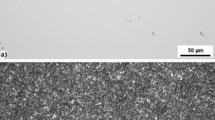Abstract
The effect of impact modification on slow crack growth in a poly(vinyl chloride) (PVC) compound was examined in order to test a methodology for predicting long-term creep fracture from short-term tension-tension fatigue tests. In all cases the crack propagated in a stepwise manner through a crack tip craze zone. Step length was analyzed in terms of the Dugdale model for a crack tip plastic zone. The overall crack growth rate in fatigue and creep followed the conventional Paris power law with the same power 2.7, da/dt = A f ΔK I 2.7 and da/dt = BK I 2.7,respectively. The effects of frequency, temperature, and R-ratio (the ratio of the minimum to maximum stress intensity factor in the fatigue loading cycle) on the Paris prefactor were determined. Crack growth rate was modeled as the product of a creep contribution that depended only on the maximum stress intensity factor and a fatigue contribution that depended on strain rate da/dt = B f K I,max 2.7 (1 + C ε, where C is a coefficient defining the strain rate sensitivity. A linear correlation allowed for extrapolation of the creep prefactor B f from fatigue data. Impact modification decreased B f but had no effect on C.
Similar content being viewed by others
References
N. Brown and X. Lu, in Proceedings of the 12th Plastic Fuel Gas Pipe Symposium, Boston, MA, 1991, p. 128.
R. Hertzberg and J. Manson, “Fatigue of Engineering Plastics” (Academic Press, New York, 1980).
L. Burn, Plast. Rub. Compos. Pro. 21 (1994) 99.
L. KÖnczÖl, W. DÖll and L. Bevan, Coll. Polym. Sci. 268 (1990) 814.
J. Mandell and J. Chevaillier, Polym. Engr. Sci. 25 (1985) 170.
H. Kim and Y. Mai, J. Mater. Sci. 28 (1993) 5479.
Y. Mai and P. Keer, J. Vinyl. Tech. 7 (1985) 130.
S. Maddox and S. Manteghi, Plast. Rub. Compos. Pro. 17 (1992) 5.
N. J. Mills and N. Walker, Polymer 17 (1976) 335.
H. S Kim and X. M. Wang, J. Mater. Sci. 29 (1994) 3209.
Y. Hu, J. Summers, A. Hiltner and E. Baer, ibid. 38 (2003) 633.
T. E. Bernal-Lara, Y. Hu, J. Summers, A. Hiltner and E. Baer, J. Vinyl Add. Tech. (in press).
P. Fitzpatrick, P. Mount, G. Smyth and R. C. Stephenson, Plast. Rub. Compos. Pro. 25 (1997) 359.
M. D. Skibo, J. A. Manson, S. M. Webler, R. W. Hetzberg and E. A. Collins, in Durability of Macromolecular Materials, ACS Symposium Series No. 95, edited by R. K. Eby (American Chemical Society, Washington, D.C., 1979) p. 311.
Rimnac, J. A. Manson, R. W. Hertzberg, S. M. Webler and M. D. Skibo, J. Macromol. Sci.-Phys. B 19 (1981) 351.
J. Phillips, R. Hertzberg and J. Manson, “Fatigue 87,” Vol. III (Engineering Materials Advisory Service Ltd., West Mildland, UK, 1987) p. 1317.
H. Kim, R. Truss, Y. Mai and B. Cotterell, Polymer 29 (1988) 268.
M. Parsons, E. V. Stepanov, A. Hiltner and E. Baer, J. Mater. Sci. 35 (2000) 1857.
Idem., ibid. 35 (2000) 2659.
L. H. Lee, J. F. Mandell and F. J. Mc Garry, Polym. Engr. Sci. 26 (1986) 626.
C. M. Rimnac, R. W. Hertzberg and J. A. Manson, J. Mater. Sci. 19 (1984) 1116.
M. G. Schinker, L. KÖnczÖl and W. DÖll, ibid. 1 (1982) 475.
W. DÖll, in “Fractography and Failure Mechanisms,” edited by A. Roulin-Moloney (Applied Science, London, 1989) p. 387.
E. Kramer and L. Berger, in “Advances in Polymer Science: Crazing in Polymers, 91/92:2,” edited by H.-H. Kausch (Springer-Verlag, New York, 1990) p. 1.
L. Berger and E. Kramer, Macromolecules 20 (1987) 1980.
H. Brown, ibid. 24 (1991) 2752.
C. Plummer and A. Donald, Polymer 32 (1991) 409.
D. S. Dugdale, J. Mech. Phys. Solids 8 (1960) 100.
S. Bensason, A. Hiltner and E. Baer, J. Appl. Polym. Sci. 63 (1997) 703.
M. Parsons, E. Stepanov, A. Hiltner and E. Baer, J. Mater. Sci. 34 (1999) 3315.
L. L. Berger, D. J. Buckley and E. J. Kramer, J. Polym. Sci. Part B: Polym. Phys. 25 (1987) 1679.
Author information
Authors and Affiliations
Corresponding author
Rights and permissions
About this article
Cite this article
Bernal-Lara, T.E., Hu, Y., Summers, J. et al. Effect of impact modification on slow crack growth in poly(vinyl chloride). Journal of Materials Science 39, 2979–2988 (2004). https://doi.org/10.1023/B:JMSC.0000025823.39995.40
Issue Date:
DOI: https://doi.org/10.1023/B:JMSC.0000025823.39995.40




